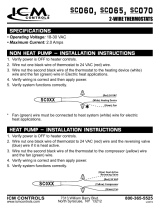
18
9.1 Connect System Supply And Return Piping
To Boiler
Connect system supply and return piping to correct
boiler ttings.
Size system circulator to supply sufcient ow (GPM)
to allow 20°F temperature differential in system.
When sizing system circulator, use single most
restrictive zone to determine maximum pressure
drop.
1.
Boiler used in connection with refrigeration systems,
install boiler so chilled medium is piped in parallel with
heating boiler using appropriate valves to prevent
chilled medium from entering boiler. See
Figure 28,
Page 31
.
2.
If boiler is connected to heating coils located in air
handling units exposed to refrigerated air, equip boiler
piping with ow control valves to prevent gravity
circulation of boiler water during operation of cooling
system.
3.
Limit control includes low water cutoff function, sensing
water level at control well in top of the rear boiler
section. Periodic inspection and testing is necessary
per instructions provided with limit control.
4.
When installation of boiler is for new heating system,
install all radiation units (panels, radiators, baseboard,
or tubing) and supply and return mains. After heating
system piping and components have been installed,
make nal connection of system piping to boiler.
Recommend mount circulating pump on supply side
piping, such that it pumps away from expansion tank.
5.
Hot water boiler installed above radiation level must
be equipped with low water cut off device. This boiler
is factory equipped with low water cutoff. Periodic
inspection is necessary, per manufacturer’s specic
instructions.
6.
When connecting cold water supply to pressure
reducing valve, make sure clean water supply is
available. When water supply is from well or pump,
install sand strainer at pump.
9.2 Bypass Piping
See Piping Diagrams for illustrations for this section.
Bypass piping may be required for applications listed
below. Failure to do so may cause damage due to thermal
shock and sustained condensation within the boiler.
Protect boiler from sustained operation of return water
temperatures lower than 130°F (54C). Occasionally,
temperatures as low as 70°F (21C) may return back to
boiler when a zone that has not been activated for some
time is opened. However, most residential systems with
nned-tube (aluminum-copper) baseboard radiation
contain low volume of water and will not adversely affect
boiler. Systems with nned-tube baseboard radiation
typically do not require bypass.
Bypass piping details shown in piping diagrams must be
used for any one of following conditions:
• All large water content systems, including cast iron
standing radiators, cast iron baseboard, converted
two-pipe steam systems, converted gravity circulation
systems and other similar systems.
• Any system, including nned-tube baseboard, with
priority domestic hot water zone.
Install ¾ inch bypass line as shown in piping diagrams
for
systems identied above.
Bypass valve cannot protect boiler from sustained
condensing operation for low temperature applications such
as radiant oor heating. These types of system require
active controls that prevent return of cold return water to
boiler.
Refer to Radiant Professional’s Alliance (RPA)
www.radiantprofessionalsalliance.org for piping
recommendations for non-condensing boiler applications.
9 - BOILER SYSTEM PIPING






















